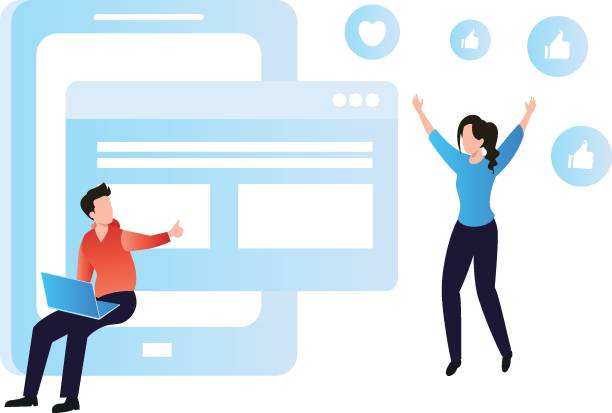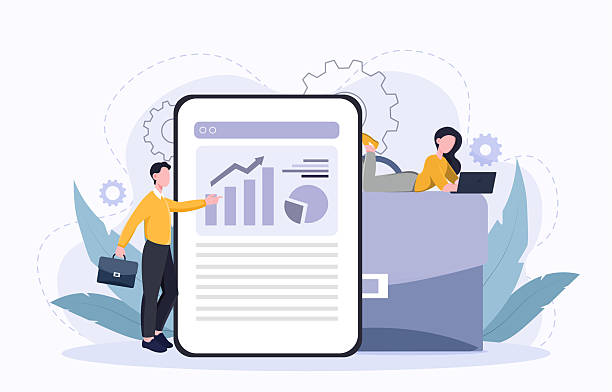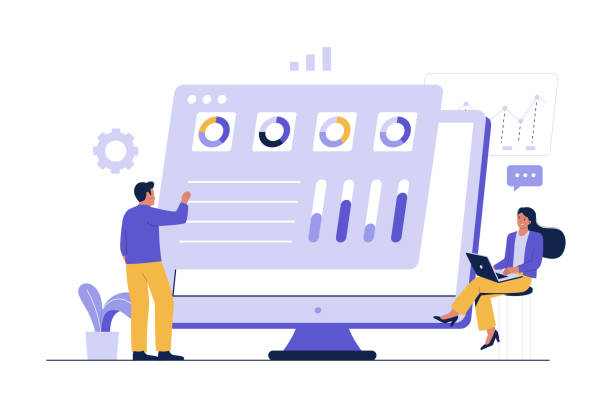Why is Multilingual Website Design a Necessity?

In today’s world, where geographical boundaries are rapidly blurring and the internet has become a bridge between different cultures and languages, the importance of multilingual website design is more apparent than ever.
A single-language website limits you to a small segment of the global audience, whereas a website with multiple languages opens new doors to international markets.
This approach not only demonstrates your respect for cultural diversity but is also a smart strategy for market expansion and increasing revenue.
#Multilingual_Website_Design is no longer a luxury option, but an essential need for any business that dreams of expanding into the #Global_Market and wants to reach an #International_Audience.
Given that billions of people worldwide speak languages other than English, ignoring this vast segment of the population means missing out on incredible opportunities.
Did you know that over 70% of internet users prefer to buy products and services from websites offered in their native language? This statistic clearly shows that investing in multilingual website design means investing in increased conversion rates and customer loyalty.
When users can read your content in a language they feel more comfortable with, the likelihood of them connecting with your brand and converting into customers significantly increases.
This initial step is the foundation for successful entry into any new market and allows you to compete with local rivals.
A powerful multilingual website not only helps you conquer new territories but also strengthens your brand’s credibility and image internationally.
This approach showcases your understanding of the needs of global e-commerce and sets you apart from other competitors.
Is your e-commerce site ready to attract maximum customers and increase sales? Rasaweb transforms your online business with modern and efficient e-commerce website design.
✅ Increased speed and improved SEO
✅ Excellent user experience on mobile and desktop⚡ Get a free consultation on e-commerce website design from Rasaweb!
Numerous Advantages of International Websites

Utilizing international websites offers numerous benefits that extend beyond mere access expansion and can significantly impact your business’s global success.
One of the most important advantages is a considerable improvement in Search Engine Optimization (SEO).
By providing content in various languages, you gain new opportunities to rank in search results for specific keywords in other languages.
This translates to increased organic traffic and attracting more visitors from different parts of the world.
Search engines recognize multilingual websites as more authoritative and comprehensive resources, which in turn helps improve your domain authority and overall ranking.
In addition to SEO, an increase in Conversion Rate is another crucial benefit.
As mentioned before, when users can understand website content in their native language, they feel more comfortable and trusting.
This sense of comfort leads to greater engagement, longer time spent on the site, and ultimately, an increased likelihood of making a purchase or using services.
This is particularly evident in the field of e-commerce, where clear and understandable communication is vital for success.
Multilingual website design also helps you strengthen your brand’s credibility and authority globally.
A company capable of communicating with its customers in different languages is perceived as a pioneering, modern, and customer-centric entity.
This positive image can play a significant role in attracting international business partners, investors, and even top talent.
Ultimately, multilingual website design creates a strong competitive advantage.
In markets where many competitors still operate in only one language, by offering services in multiple languages, you differentiate yourself and gain access to markets that are inaccessible to them.
This strategic approach allows you to establish a foothold in new markets and significantly increase your market share.
Investing in multilingual website design is a long-term, smart decision for any business seeking sustainable growth and development in the international arena.
Main Challenges in Design and Implementation

Although the benefits of multilingual website design are numerous, its implementation path is not without challenges.
Understanding these challenges and planning to address them is key to success in this field.
One of the most significant obstacles is translation accuracy and quality.
Translation is not merely replacing words; rather, it must convey the content to the target language while preserving its original meaning, tone, and even humor.
Relying solely on machine translation tools is insufficient and often leads to inaccurate and unnatural translations that can harm brand credibility.
To ensure quality, investing in professional localization translators who are familiar with the culture and idioms of the target language is essential.
Another challenge is technical and infrastructural issues.
Multilingual websites require an appropriate URL structure (such as subdomains, subdirectories, or separate domains), correct use of hreflang tags to indicate different language versions of a page, and database management capable of storing content in multiple languages.
These technical issues are complex and require technical expertise to prevent SEO and user experience problems.
For instance, languages like Persian or Arabic, which are written from right-to-left (RTL), necessitate specific CSS settings and UI design that might not be present in left-to-right (LTR) languages.
Content management is also a significant challenge.
As the number of languages increases, the volume of content that needs to be managed, updated, and harmonized significantly grows.
The need for a powerful and flexible Content Management System (CMS) that supports multiple languages and has an efficient workflow for content translation and publication is crucial.
Finally, the issue of budget and time is also relevant.
Multilingual website design is an investment, requiring commitment not only financially but also in terms of time and human resources.
Careful planning, choosing the right platform, and collaborating with expert teams can turn these challenges into opportunities and contribute to the success of your multilingual website design project.
Some Common Challenges in Multilingual Website Design and Their Solutions:
| Challenge | Description | Suggested Solution |
|---|---|---|
| Translation Quality | Machine translation is insufficient and can lead to significant errors. | Utilize professional native translators and cultural localizers. |
| SEO Issues | Errors in URL structure and Hreflang tags can harm rankings. | Correct implementation of Hreflang tags and selection of appropriate URL structure (subdirectory, subdomain). |
| Content Management | Tracking and updating content in multiple languages is difficult. | Use a robust multilingual CMS and a Translation Management System (TMS). |
| UI/UX Design | Need for adaptability to text direction (RTL/LTR) and different font sizes. | Responsive and flexible design considering the specific characteristics of each language. |
The Importance of Localization Beyond Translation

Many people assume that multilingual website design merely means translating words from one language to another, but in reality, this approach goes far beyond simple translation and encompasses the deeper concept of Localization.
Localization means adapting content and products to the culture, customs, and expectations of local audiences in the target market.
This includes details that might seem insignificant at first glance but actually have a significant impact on user experience and your brand’s acceptance.
For example, differences in date formats (Gregorian versus Solar Hijri), units of measurement (metric versus imperial), address and phone number formats, and even colors and images that might have a positive meaning in one culture and a negative meaning in another, all must be considered in the localization process.
The appeal of localized content to the audience is significantly greater than that of merely translated content.
When users feel that the website is specifically designed for them, they establish a deeper connection with the brand.
This includes adapting to common idioms, local humor (if necessary and appropriate), and even formal or friendly modes of address when communicating with the audience.
A localized website shows customers that you value them and their culture.
This can lead to increased trust and, ultimately, customer loyalty.
Furthermore, localization also involves legal considerations and local payment options.
In each country, there may be specific laws and regulations for e-commerce, data privacy, and consumer protection with which your website must comply.
Additionally, offering popular local payment options, such as specific credit cards or common online payment systems in that country, can make the purchasing experience much easier for users.
Ignoring localization aspects can lead to cultural misunderstandings, rejection of products or services, and even legal issues.
Therefore, every successful multilingual website design project must place localization as a core pillar in its strategy, rather than just an afterthought.
This comprehensive approach ensures effective communication with global audiences and sustainable success in international markets.
Are you tired of your e-commerce website not generating revenue up to its full potential? Rasaweb, specializing in professional e-commerce website design, solves this problem forever!
✅ Increased sales and revenue rates
✅ High load speed and unparalleled user experience
⚡ Get a free consultation on e-commerce website design now!
Choosing the Right Platform for Your Multilingual Site

Choosing the right platform is a crucial step in the process of designing your multilingual website.
This decision can profoundly impact the complexity of implementation, maintenance costs, scalability capabilities, and future flexibility of your website.
Various platforms are available for managing multilingual content, each with its own advantages and disadvantages.
The most common options include Content Management Systems (CMS) like WordPress, Drupal, Joomla, as well as custom solutions or web development frameworks.
WordPress, with its powerful plugins like WPML or Polylang, is one of the most popular options for multilingual website design.
Its ease of use, large user community, and abundant educational resources are among its advantages.
However, for very large and complex projects, it may require deeper customizations.
Drupal is a more powerful and flexible CMS that natively supports multilingual capabilities and is better suited for enterprise websites and large projects with complex needs.
Drupal’s learning curve is slightly steeper, but it provides unparalleled features for experienced developers.
Joomla is another CMS that offers internal multilingual support and falls between WordPress and Drupal in terms of complexity.
Platform selection should be based on specific project needs, budget, the development team’s expertise level, and your long-term plans.
If you intend for your website to expand into many languages in the future, choose a platform with high scalability and a flexible architecture.
Additionally, you should consider the ecosystem of plugins and tools supporting multilingualism within the chosen platform.
Some platforms have powerful built-in tools for translation and localization management, while others rely on third-party plugins.
Ultimately, consulting with multilingual website design specialists can help you choose the best platform to achieve your global goals.
This correct choice provides the foundation for an efficient and successful multilingual website and prevents future troubles.
Search Engine Optimization (SEO) in Multilingual Projects
![]()
The success of any multilingual project would be incomplete without adhering to Search Engine Optimization (SEO) principles for each language.
Multilingual SEO is not just about translating keywords; it requires a comprehensive approach that includes technical, content-related, and off-page SEO aspects.
The most important technical aspect is the correct implementation of hreflang tags. These tags inform search engines like Google which version of the page is intended for which language and geographical region, and they prevent duplicate content issues.
Without these tags, search engines may not be able to correctly index different language versions, which harms your rankings.
URL structure also plays a vital role in multilingual SEO.
You can use subdirectories (e.g., yoursite.com/fa/), subdomains (fa.yoursite.com), or country-code top-level domains (e.g., yoursite.ir).
Each method has its pros and cons, but the important thing is to choose a consistent and logical structure that is understandable to both users and search engines.
For content, keyword research must be conducted separately for each language and region.
Keywords common in one language or culture might have a different meaning or not be used at all in another language or culture.
Utilizing local keyword research tools and understanding the search needs of the target audience in each language is essential.
Also, content should not only be translated but also localized to match the local tone and idioms.
Finally, link building and domain authority must also be considered.
To improve SEO in each language, quality links from relevant local websites in each country or region should point to your multilingual website.
This indicates to search engines that your website is credible and relevant in that region as well.
Ignoring SEO in multilingual website design means losing a significant portion of organic traffic and business potential.
Therefore, a comprehensive and precise SEO strategy should be considered from the very beginning, alongside the design and development of your multilingual website.
Content Management and Updates in Multilingual Sites

One of the biggest operational challenges in maintaining multilingual sites is the efficient management of content and its update process across all languages.
As the number of languages increases, the complexity and workload also grow exponentially.
Without a proper strategy and tools, content updates can turn into a nightmare, leading to inconsistencies, outdated information, and poor user experience.
The first crucial step is to have a Content Management System (CMS) with robust multilingual capabilities. This CMS should allow you to manage content for each language separately, while also maintaining the connection between different versions of a page.
Features such as easy translation, copying content between languages, and viewing translation status for each section are essential.
Many systems utilize user-friendly interfaces for managing translations, which simplifies the process for content editors.
The next step is to establish a clear workflow for content translation and updates. This includes defining responsibilities, scheduling translations, review and approval processes, and coordination between content teams and translators.
Using Translation Management Systems (TMS) or CAT (Computer-Assisted Translation) tools can help improve efficiency.
These tools provide features like Translation Memory and Terminology Databases, which significantly help maintain consistency in translations and reduce time and cost in large projects.
Also, the importance of quality control in multilingual content cannot be overlooked.
After translation, the content must be reviewed by native speakers and subject matter experts to ensure accuracy, cultural correctness, and fluency of the text.
This review process includes not only text but also images, videos, and any other visual elements that may require localization.
Remember that multilingual sites require continuous maintenance.
Content should be regularly updated, outdated information removed, and new content added.
Careful planning for periodic updates and coordination among teams ensures that your multilingual website consistently provides accurate and up-to-date information to global audiences.
This comprehensive approach to content management is one of the main pillars for the long-term success of a multilingual website.
Tools and Strategies for Multilingual Content Management:
| Tool/Strategy | Description | Advantages |
|---|---|---|
| Multilingual CMS | Content Management Systems with native multilingual capabilities (e.g., Drupal, some WordPress configurations). | Integrated content management, ease of publishing and updating. |
| Translation Management System (TMS) | Specialized platforms for managing translation projects (e.g., Phrase, Smartling). | Improved translation workflow, translation memory, terminology database. |
| Translation Memory (TM) | A database of previously translated segments for reuse and consistency. | Reduced translation time and cost, increased lexical consistency. |
| Content Review Process | Thorough review of translated content by native speakers and subject matter experts. | Ensuring accuracy, cultural correctness, and high text quality. |
User Experience (UX) and User Interface (UI) in Multilingual Website Design

In multilingual website design, User Experience (UX) and User Interface (UI) gain additional importance.
A website might have excellent translated content, but if users cannot easily access or use it, all efforts will be in vain.
The first key point is to provide a clear and accessible option for language switching. This language switcher should be placed in a prominent and logical location, usually in the header or footer.
Using standard symbols (such as country flags, although not recommended because a language does not belong to a specific country but is associated with ethnicities or language groups; it is better to use ISO 639-1 language codes like EN, FR, FA) and a dropdown list with full language names is the best approach.
Responsive Design is also crucial for multilingual websites.
This means that the design must adapt well to different text lengths in various languages (some languages are longer than English, like German, while others are more compact, like Chinese).
Whitespace and element layout must be such that content is displayed beautifully and legibly in any language.
Furthermore, special attention must be paid to Text Direction.
For languages like Persian, Arabic, and Hebrew, which are written from right-to-left (RTL), the UI design must fully reflect this direction; from column arrangement to the placement of icons and forms.
This requires deep changes in CSS and HTML to provide a native and natural user experience.
In addition, website Navigation must be consistent and understandable across all languages.
The structure of menus and page hierarchy should remain logical, even if terms are translated.
Usability Testing with native users in each language helps identify potential UX and UI issues and ensures that the website is truly usable and enjoyable for the target audience.
A successful multilingual website design goes beyond translating words and localizes all visual and interactive aspects to provide a flawless experience for global users.
Does your current website convert visitors into customers or drive them away? Solve this problem forever with professional corporate website design by Rasaweb!
✅ Build strong credibility and branding
✅ Attract target customers and increase sales
⚡ Get a free consultation now!
A Look at the Future of Multilingual Website Design and Artificial Intelligence

The future of multilingual website design is strongly linked to advancements in Artificial Intelligence (AI) and Machine Learning (ML).
AI has the potential to revolutionize how multilingual content is created, managed, and delivered.
From Neural Machine Translation (NMT), which is becoming increasingly accurate and fluent, to automated localization systems and content personalization, AI is redefining the boundaries of global communication.
One of the most significant impacts of AI is on improving translation quality.
NMT models, with their enhanced ability to understand context and meaning, produce translations that are much more natural than previous generations.
This can significantly reduce the time and cost required for manual translation, although human review and editing are still necessary to ensure accuracy and complete localization.
Nevertheless, AI can serve as a powerful tool for initial drafts and accelerating the process.
In addition to translation, AI can also play a role in content personalization.
By analyzing user behavior, AI can dynamically adjust content based on language, geographic region, browsing history, and even cultural preferences.
This means that a multilingual website can automatically tailor images, product recommendations, or even the tone of the message based on each visitor’s characteristics, leading to an exceptionally personalized user experience and increased conversion rates.
The future may include systems that create new content in a primary language and then automatically translate and localize it into multiple other languages, while also considering all SEO and cultural aspects. This can significantly simplify the process of multilingual website design and maintenance.
However, ethical questions and challenges such as bias in AI training data, and the need to preserve human originality and creativity in content, remain relevant.
It is predicted that collaboration between AI and human expertise will shape the future of multilingual website design, where AI automates repetitive tasks and humans focus on strategic, creative, and deeper localization aspects.
Practical Steps for Successfully Launching Your Multilingual Site

Launching a multilingual site requires careful planning and systematic execution.
By following practical and strategic steps, you can ensure your project succeeds and you achieve your global goals.
Step One: Define Goals and Audience. First and foremost, you need to clarify why you need a multilingual website, which markets you are targeting, and what languages your audience in these markets speaks.
Defining these goals helps you make subsequent decisions based on a clear vision and prevents wasted resources.
Step Two: Select Target Languages. Based on your goals and market research, choose the languages that have the most potential for your business.
You don’t need to translate into dozens of languages from the start; you can begin with a few main languages and gradually expand.
Step Three: Choose URL Structure and Platform. Decide whether you will use subdirectories, subdomains, or separate domains for each language.
Then, select the appropriate CMS platform (such as WordPress with multilingual plugins, Drupal, or custom solutions) that provides the best support for your multilingual needs.
Step Four: Content Creation and Localization. This stage involves translating all existing content and producing new localized content.
Emphasizing localization beyond mere translation, and utilizing professional native translators and cultural specialists, is crucial.
This includes texts, images, videos, and any other elements present on your website.
Step Five: Technical Implementation and Multilingual SEO. Ensure that hreflang tags are correctly implemented and your URL structure is optimized for search engines.
Also, conduct keyword research for each language and optimize content accordingly.
Attention to technical aspects such as site loading speed and compatibility with various devices is also important.
Step Six: Testing and Launch. Before public launch, thoroughly test the website to ensure the correct functioning of all multilingual features, proper content display, and optimal user experience.
Use native speakers for final testing.
Step Seven: Ongoing Maintenance and Improvement. Multilingual website design is not a one-time process.
Regularly update content, monitor site performance, and consider user feedback for future improvements.
By following these steps, you can create a powerful and successful multilingual website that helps you reach global audiences and expand your business.
Frequently Asked Questions
| No. | Question | Answer |
|---|---|---|
| 1 | What is multilingual website design? | Multilingual website design means building a website whose content is available to users in several different languages. This is usually done through a simple user interface for language switching. |
| 2 | Why should we design a multilingual website? | Multilingual website design helps you reach more audiences worldwide, provide a better user experience for international users, and improve your global SEO. |
| 3 | What are the main methods for implementing multilingualism on a website? | The main methods include using subdomains, subdirectories, or URL parameters for each language, as well as using completely separate domains for each language. |
| 4 | Is it better for SEO to use subdirectories or subdomains? | From an SEO perspective, both subdirectories and subdomains can be effective. However, many SEO experts prefer subdirectories due to better transfer of the main domain’s authority. |
| 5 | What are the important points in translating multilingual website content? | Translation should be done by native translators, content should be localized in addition to translation to match the target audience’s culture, and pure machine translation should be avoided. |
| 6 | What is the role of the hreflang tag in multilingual website SEO? | The hreflang tag helps search engines like Google display the correct language and regional version of a page to the appropriate users, which also prevents duplicate content issues. |
| 7 | Can a website be made multilingual without coding? | Yes, in Content Management Systems (CMS) like WordPress, there are powerful plugins such as WPML or Polylang that enable multilingual website creation without requiring coding. |
| 8 | What are the challenges of multilingual website design? | Challenges include translation management, content localization, adhering to SEO principles for each language, technical support for different languages, and ensuring design consistency across different languages. |
| 9 | What is the difference between translation and localization? | Translation is merely rendering words from one language to another, while localization involves adapting content to the culture, customs, currency, date and time formats, and even appropriate colors for the target audience. |
| 10 | What is the best User Experience (UX) for language switching? | A clear and accessible language switcher (usually in the header or footer), using the language name instead of flags (due to regional diversity), and maintaining the user’s position after changing the language are important UX considerations. |
And other services of Rasaweb Advertising Agency in the field of advertising
Smart Advertorial: A novel service to improve SEO ranking through key page optimization.
Smart Digital Branding: A combination of creativity and technology to increase sales through user experience customization.
Smart Social Media: An effective tool for user engagement with the help of Google Ads management.
Smart Advertorial: A combination of creativity and technology for user engagement through custom programming.
Smart Digital Branding: A combination of creativity and technology for digital branding through intelligent data analysis.
And over hundreds of other services in the field of internet advertising, advertising consulting, and organizational solutions
Internet Advertising | Advertising Strategy | Advertorial
Resources
Advantages of Multilingual Website Design for Businesses
Best Content Management System for Multilingual Sites
SEO Tips for Multilingual Sites
Successful Multilingual Website Design Case Studies
? To elevate your business in the digital world, Rasaweb Afarin Digital Marketing Agency is your guide with comprehensive services, from modern UI website design to targeted marketing strategies.
📍 Tehran, Mirdamad Street, next to Central Bank, Kazeroon Jonoubi Alley, Ramin Alley, No. 6




